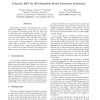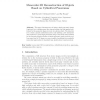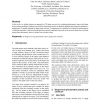141
click to vote
CVPR
2012
IEEE
13 years 3 months ago
2012
IEEE
We consider the problem of shape recovery for real world scenes, where a variety of global illumination (interreflections, subsurface scattering, etc.) and illumination defocus e...
104
click to vote
CVPR
2012
IEEE
13 years 3 months ago
2012
IEEE
We propose a novel framework for reconstructing homogenous, transparent, refractive height-fields from a single viewpoint. The height-field is imaged against a known planar back...
113
click to vote
PAMI
2012
13 years 3 months ago
2012
— Most recent approaches to monocular non-rigid 3D shape recovery rely on exploiting point correspondences and work best when the whole surface is well-textured. The alternative ...
114
Voted
ICCV
2011
IEEE
14 years 17 days ago
2011
IEEE
In this paper we propose a new method for the simultaneous segmentation and 3D reconstruction of interest point based articulated motion. We decompose a set of point tracks into r...
120
Voted
AUSAI
2006
Springer
15 years 2 months ago
2006
Springer
Estimating the structure of the human face is a long studied and difficult task. In this paper we present a new method for estimating facial structure from only a minimal number o...
110
Voted
CVPR
2010
IEEE
15 years 3 months ago
2010
IEEE
The 3D reconstruction of a face from a single frontal image is an ill-posed problem. This is further accentuated when the face image is captured under different poses and/or compl...
115
click to vote
ICIAP
1999
ACM
15 years 4 months ago
1999
ACM
The paper presents a new approach for shape recovery based on integratinggeometric and photometric information. We consider 3D bilaterally symmetric objects, that is, objects which...
102
Voted
PSIVT
2009
Springer
15 years 5 months ago
2009
Springer
This paper discusses ways of using a single panoramic image (captured by a rotating sensor-line camera having very-high spatial resolution) for the geometric shape recovery of a sh...
107
click to vote
CAIP
2003
Springer
15 years 5 months ago
2003
Springer
In this work, we further discuss an approach to 3D shape recovery by combining photometric stereo and shape from contours methods. Surfaces recovered by photometric stereo are ali...
91
Voted
ECCV
2006
Springer
16 years 2 months ago
2006
Springer
Abstract. Human faces are remarkably similar in global properties, including size, aspect ratios, and locations of main features, but can vary considerably in details across indivi...




